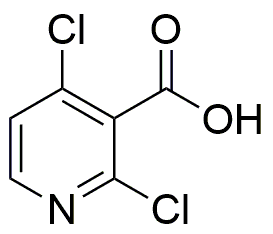2,4-Dichloronicotinic acid is widely utilized in research focused on:
- Pesticide Development: This compound serves as a key intermediate in the synthesis of various agrochemicals, particularly insecticides and herbicides, enhancing crop protection and yield.
- Pharmaceuticals: It is used in the development of new drugs, especially those targeting neurological disorders, due to its ability to interact with specific receptors in the brain.
- Material Science: The compound is explored for its potential in creating advanced materials, such as polymers and coatings, that require specific chemical properties for durability and performance.
- Research in Biochemistry: It acts as a valuable reagent in biochemical assays, aiding researchers in studying metabolic pathways and enzyme activities.
- Environmental Chemistry: The compound is investigated for its role in environmental remediation processes, helping to break down pollutants in soil and water.
General Information
Properties
Safety and Regulations
Applications
2,4-Dichloronicotinic acid is widely utilized in research focused on:
- Pesticide Development: This compound serves as a key intermediate in the synthesis of various agrochemicals, particularly insecticides and herbicides, enhancing crop protection and yield.
- Pharmaceuticals: It is used in the development of new drugs, especially those targeting neurological disorders, due to its ability to interact with specific receptors in the brain.
- Material Science: The compound is explored for its potential in creating advanced materials, such as polymers and coatings, that require specific chemical properties for durability and performance.
- Research in Biochemistry: It acts as a valuable reagent in biochemical assays, aiding researchers in studying metabolic pathways and enzyme activities.
- Environmental Chemistry: The compound is investigated for its role in environmental remediation processes, helping to break down pollutants in soil and water.
Documents
Safety Data Sheets (SDS)
The SDS provides comprehensive safety information on handling, storage, and disposal of the product.
Product Specification (PS)
The PS provides a comprehensive breakdown of the product’s properties, including chemical composition, physical state, purity, and storage requirements. It also details acceptable quality ranges and the product's intended applications.
Certificates of Analysis (COA)
Search for Certificates of Analysis (COA) by entering the products Lot Number. Lot and Batch Numbers can be found on a product’s label following the words ‘Lot’ or ‘Batch’.
*Catalog Number
*Lot Number
Certificates Of Origin (COO)
This COO confirms the country where the product was manufactured, and also details the materials and components used in it and whether it is derived from natural, synthetic, or other specific sources. This certificate may be required for customs, trade, and regulatory compliance.
*Catalog Number
*Lot Number
Safety Data Sheets (SDS)
The SDS provides comprehensive safety information on handling, storage, and disposal of the product.
DownloadProduct Specification (PS)
The PS provides a comprehensive breakdown of the product’s properties, including chemical composition, physical state, purity, and storage requirements. It also details acceptable quality ranges and the product's intended applications.
DownloadCertificates of Analysis (COA)
Search for Certificates of Analysis (COA) by entering the products Lot Number. Lot and Batch Numbers can be found on a product’s label following the words ‘Lot’ or ‘Batch’.
*Catalog Number
*Lot Number
Certificates Of Origin (COO)
This COO confirms the country where the product was manufactured, and also details the materials and components used in it and whether it is derived from natural, synthetic, or other specific sources. This certificate may be required for customs, trade, and regulatory compliance.


